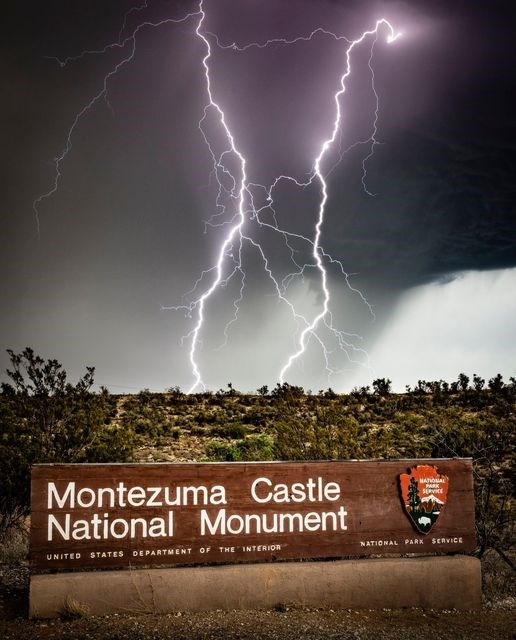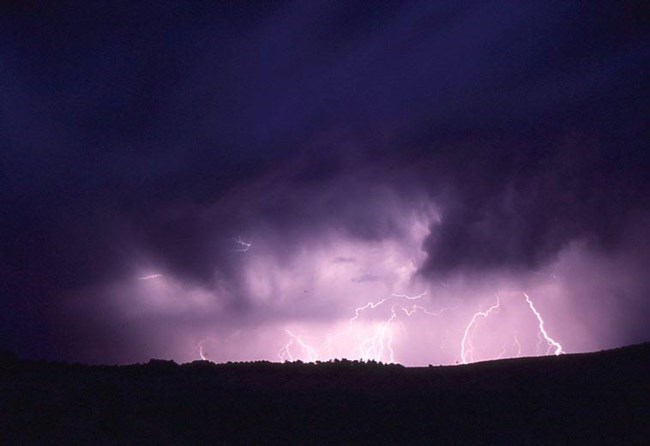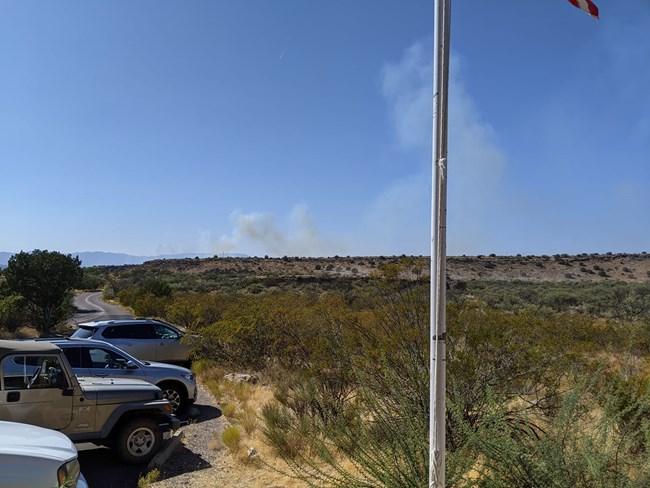|
Although the landscapes within Montezuma Castle National Monument may appear harsh and unchanging, the desert ecosystem is continually evolving. Weather, climatic shifts, and geologic processes continue to shape this environment as they have for millennia. More recently, human-caused factors such as air, noise, and water pollution, as well as introduced species, have had a much greater impact on natural resources world-wide. The undeveloped landscapes of Montezuma Castle and Montezuma Well provide an ideal place to study how various environmental factors affect desert ecosystems, and predict what changes might be expected in the future.

NPS Photo / Nicholas Goodman Air PollutionClean air helps people breathe easy and see far. It keeps our parks and planet healthy too! Air pollution in parks can have negative consequences for how well we can see park vistas, the health of natural environments, the health of people in and around parks, and even the strength of local economies. With the exception of visibility, most of the effects in parks result from extended exposure to air pollution rather than short-term events. Learn more about the effects of air pollution in parks by viewing Park Air Profiles or the Air Quality Related Values Inventory page. 
NPS Photo Climate MonitoringPrecipitation and temperature are primary factors that determine an ecosystem's structure and function. Secondary factors include long-term climate patterns, such as the timing, duration, and intensity of extreme weather events (such as frosts and violent downpours), and the variance in seasonal dynamics between and among years. These drivers greatly influence which plant species occur where, habitat suitability for wildlife, surface and subsurface hydrology, how nutrients are cycled, and the relationships between soil, plants, and water availability. They can also affect how susceptible—or resilient—an ecosystem is to disturbance. Climate change in parksWe can already see the effects of climate change in many national parks. But because national parks are protected areas, they can carry out research to help support informed decisions for protecting our resources. Parks also work to educate visitors about climate change and show them first-hand how these changes are impacting our resources. Current researchResearch at Montezuma Castle has shown that continuing changes in climate can potentially change the animal and plant populations at the monument. This means that some species will not be able to survive at the monument in the future. Another study found that recent climatic conditions at the monument are already shifting beyond historic ranges. In the future, climate change may manifest itself not only as changes in average conditions, but also as more extreme individual weather events, like floods or storms. Water QualityMany National Park Service units in the American Southwest were established to protect precious cultural resources. In most cases, however, the surrounding natural environment is an equally significant part of the story. At Montezuma Castle and Tuzigoot National Monuments, in central Arizona, the remains of the precontact built environment reflect the importance of reliable water sources.Climate and Water Monitoring ReportsLight PollutionIt may be difficult to understand at first—how could something as common as light be considered a pollutant? After all, the day is full of light, so how could a little light at night be a problem? The answer is simply that even a small amount of light can greatly change the essence of night and the natural processes that occur then. Artificial light is a powerful tool that humans wield, only becoming common with the widespread use of electricity. One needs only to glimpse upon on a nighttime view of our planet from space to see how pervasive artificial light is at night.Learn more about light pollution. 
NPS Photo MonsoonsWhile the threat of flash floods and lightning strikes can seem overwhelming, monsoon season can also be a beautiful time of year. If you are planning a trip during monsoon season, stay safe during storms and check the forecast before visiting. Heavy rainfall can cause washes and bodies of water like Beaver Creek to rise by several feet very quickly. Afterward, take a look outside to see just how much these crucial rains change the landscape. Smell the rain-soaked dirt and watch plants and flower come back to life.Learn more about the importance and dangers of monsoons. 
NPS Photo Wildland Fire Science and ResearchFire is a powerful and enduring force that has had, and will continue to have, a profound influence on National Park Service (NPS) lands. Restoring and maintaining this natural process are both important management goals for many NPS areas. Therefore, information about the use and effect of prescribed fire on park resources is critical to sound, scientifically based management decisions. Using results from a high quality monitoring program to evaluate a park’s prescribed fire management program is the key to successful adaptive management. By using monitoring results to determine whether management objectives are being met, managers can verify that the program is on track, or conversely, discern clues as to what may not be working as planned so that appropriate changes can be made.Learn more about wildland fire science and research. What Can You Do To Help?
|
Last updated: December 6, 2025
